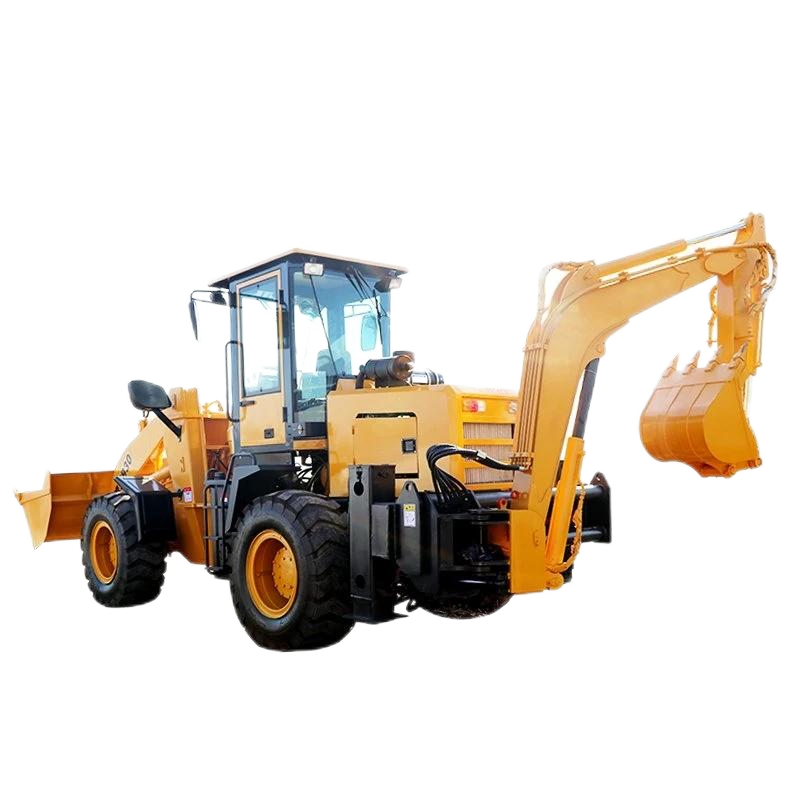Backhoe loaders and wheel loaders are two types of equipment commonly used in engineering construction. They have significant differences in functions, applicable scenarios, structural design, etc. When making a choice, it is necessary to consider specific operational needs. The following is a detailed comparative analysis from multiple dimensions to help you make a more appropriate choice:

I. Equipment Definitions and Core Functions
1. Backhoe Loader (commonly known as "two-way machine")
- Structural features: It serves two purposes in one machine. The front end is equipped with a loader bucket, and the rear end is equipped with an excavator arm and bucket. The working mode can be quickly switched through the hydraulic system.
- Core functions: It integrates loading and excavating functions. It can not only shovel and transport bulk materials (such as sand, gravel, and soil) like a loader but also perform operations such as excavating, crushing, and hoisting (such as digging trenches and foundation pits) like an excavator.
- Flexibility: The body is relatively compact with a small turning radius, making it suitable for flexible operation in narrow spaces (such as rural house foundations and small construction sites) without the need for frequent equipment replacement.
2. Wheel Loader
- Structural features: Only the front end is equipped with a large bucket, with tires as the running gear, relying on strong power and bucket capacity for operation.
- Core functions: It focuses on loading operations, mainly used for shoveling loose materials (such as ore and construction waste), and cooperating with trucks for short-distance transportation, or stacking and transporting in yards and ports.
- Efficiency advantage: It has a large bucket capacity (usually 1-10 cubic meters) and fast operation speed, suitable for large-scale and high-intensity loading tasks.
II. Comparison of Applicable Scenarios
| Equipment Type | Core Applicable Scenarios | Inapplicable Scenarios |
|---|---|---|
| Backhoe Loader | - Small earthworks (such as foundation excavation for rural house construction, small ditch digging) - Comprehensive operations in narrow sites (such as simultaneous excavation and material clearance in municipal maintenance) - Short-distance material transfer (no need for large trucks after shoveling) - Multi-functional auxiliary operations (such as crushing small stones with a breaker) | - High-intensity excavation tasks in large mines, quarries, etc. - Scenarios requiring long-distance transportation of large amounts of materials (low efficiency) - Heavy loading (such as large-volume ores, steel) |
| Wheel Loader | - Material shoveling and stacking in large yards (such as cement plants, sand and gravel yards) - Large-scale earthwork transfer in cooperation with trucks (such as expressway construction) - Heavy material loading (such as auxiliary handling of steel, containers) - Site leveling and cleaning operations (using the bucket to level the ground) | - Scenarios requiring deep or precise excavation (no excavation function) - Operations in narrow spaces (large body, poor flexibility) - Multi-process composite operations (need to be matched with excavators and other equipment) |
III. Comparison of Key Performance Parameters
- Operation efficiency: The loading efficiency of wheel loaders is much higher than that of backhoe loaders (they can handle more materials in the same time). However, backhoe loaders excel in completing excavation + loading "one-stop", reducing equipment switching time.
- Mobility: Backhoe loaders have a shorter body and a small turning radius, suitable for complex terrains; wheel loaders have a fast driving speed (some can reach 30-40km/h), suitable for long-distance transfer.
- Cost: The unit price of backhoe loaders is higher (due to integrating dual functions), but they can replace one loader + one small excavator, which may reduce the total equipment procurement cost in the long run; the unit price of wheel loaders is relatively lower, and the maintenance cost is also simpler.
- Maintenance difficulty: Wheel loaders have a simpler structure, fewer wearing parts, and are easier to maintain; backhoe loaders have more complex hydraulic systems, with slightly higher maintenance costs and difficulty.
IV. Selection Suggestions
- Give priority to operational needs:
- If the main task is loading (such as in yards, large-scale engineering transfer), choose a wheel loader;
- If both excavation and loading are needed (such as small projects, narrow sites), choose a backhoe loader.
- According to the site size:
- Narrow sites, multi-process operations → backhoe loader;
- Open sites, single loading tasks → wheel loader.
- Consider cost and equipment matching:
- Limited budget, only need loading function → wheel loader;
- Need to save the number of equipment and take into account multiple tasks → backhoe loader.
- Long-term operation nature:
- Long-term high-intensity single operation → wheel loader (high efficiency, low maintenance);
- Short-term flexible operation, multi-scenario switching → backhoe loader (strong adaptability).
Summary
Backhoe loaders are "all-rounders" suitable for small and medium-sized, multi-functional demand scenarios; wheel loaders are "professional loading tools" suitable for large-scale and high-intensity loading tasks. The choice should be comprehensively judged based on the specific project scale, operation content, site conditions, and cost budget. When necessary, you can consult equipment manufacturers for on-site working condition evaluation.





